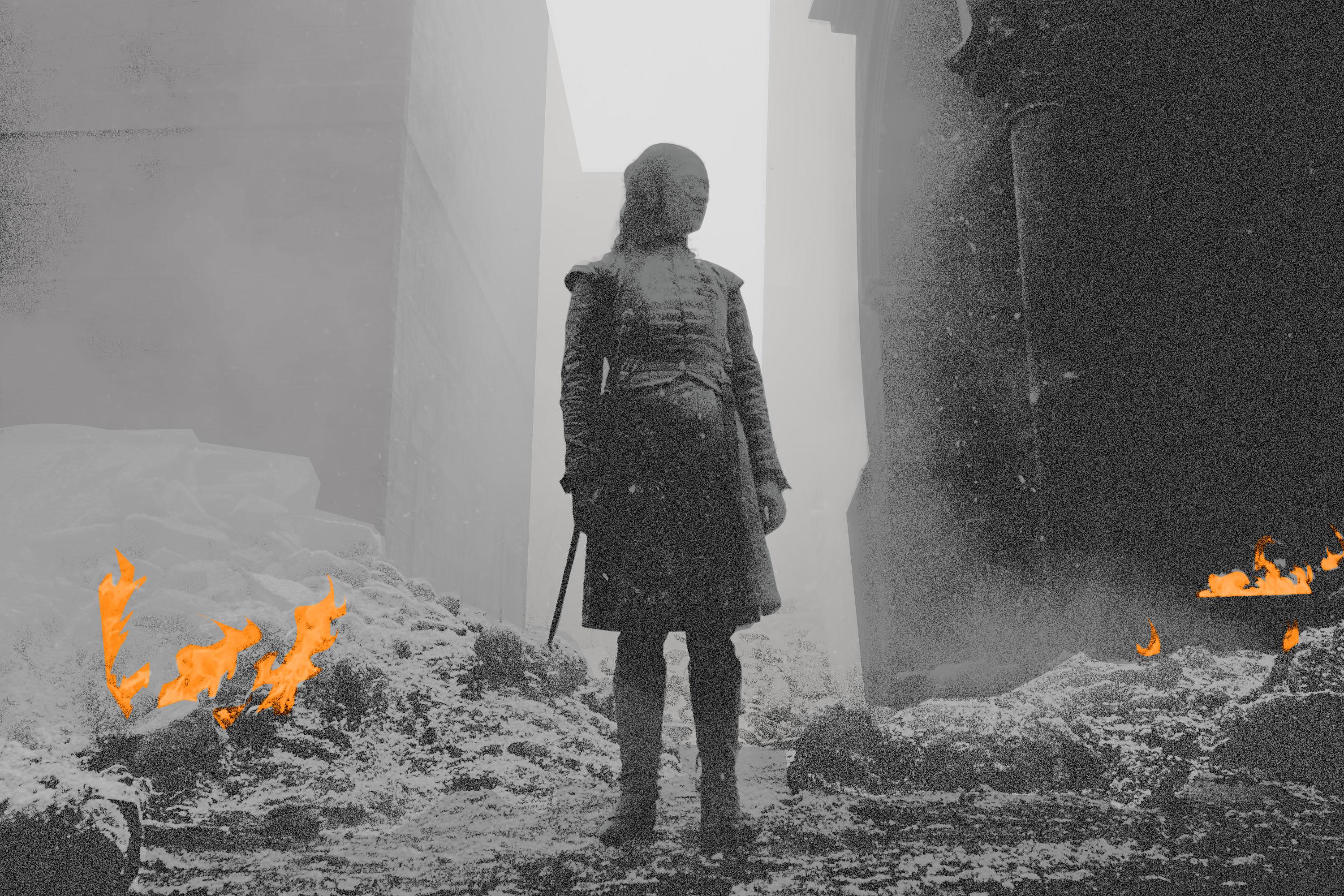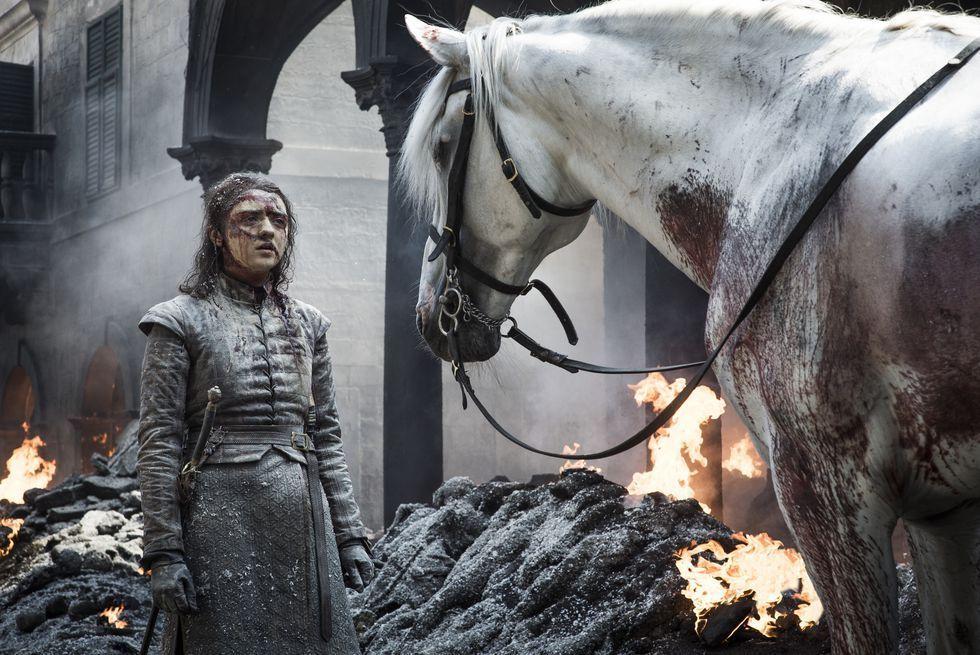Has Arya Added a New Name to Her List?
After slaying the Night King, a Mad Queen looms heading into the series finale of ‘Game of Thrones’

“I know death,” Arya Stark tells her soon-to-be-lover Gendry Baratheon in the second episode of Game of Thrones’ final season. “He’s got many faces. I look forward to seeing this one.” This casual flex preceded Winterfell’s existential battle against the White Walkers, an undead nightmare that repositioned Arya’s declaration as ill-fated hubris. This version of death never tired, numbered in the tens of thousands, and would try to kill you if you made any noises in the library. But the White Walkers’ humbling of Arya ultimately gave way to her crowning achievement (though we need to give a shout-out to Melisandre for a clutch halftime pep talk). She pierced the Night King with her Valyrian steel dagger, ending the biggest threat to humanity and the realm with a single blow. Arya vanquished death, and, as Melisandre once foretold, shut a pair of blue eyes forever.
But even with the Night King and his army decimated, death is not defeated. It has other faces. Arya saw that firsthand in Thrones’ penultimate episode, “The Bells,” which placed her in the unfettered chaos that erupted through the streets of King’s Landing as Daenerys Targaryen took Missandei’s final word of “Dracarys” a little too literally in burning everything to ash and rubble. We may quibble with how late-era Thrones haphazardly arrived at the “Mad Queen” Daenerys, but the end result was a visual, visceral spectacle rarely seen on television. (One that was much easier to see than “The Long Night.”)
If “The Bells” merely subjected viewers to aerial shots of Dany massacring innocent civilians, it wouldn’t have had quite the emotional impact the series intended. But seeing a key point-of-view character like Arya hurriedly darting through the carnage, trying in vain to save innocents from Drogon’s flames, provided a much-needed personal touch—and seeing that we had only two episodes remaining, Arya’s journey had actual life-or-death stakes.
So many characters on Thrones have been subjected to physical and psychological horrors, but Arya has perhaps consistently endured the most trauma at a young age: from her father’s execution in King’s Landing to the torturous halls of Harrenhal to the worst study abroad experience in Braavos to the climactic battles of ice and fire in the final season. While Arya has vacillated between embracing her Stark identity and being “No One,” she’s consistently had a taste for Quentin Tarantino–like violence. (I’m not totally convinced he didn’t ghostwrite Ser Meryn Trant’s death scene.) The bitter irony is that in the last seasons, Arya has finally seemed willing to shut the door on this cycle of brutality, choosing to go north rather than assassinate Cersei in Season 7, embracing life before the Battle of Winterfell, and, in a tender moment in this episode, heeding the Hound’s words to be the best version of herself that she can be. Arya didn’t need to kill Cersei; maybe it was time to finally throw the kill list away.
But those chaotic moments in the decimated streets of King’s Landing underscored that, well, there’s still work to be done. Arya and Sansa never warmed up to Dany the way Jon Snow did, but given the way Jon witnessed the horror’s unfolding from his own purview on the ground, it’s evident that Dany will preside over the ashes of King’s Landing with a new set of enemies. Of course, the problem that Cersei and her forces dealt with remains: Dany has the Westerosi equivalent of a nuclear weapon she can ride like a horse, and the North spent all their time prepping dragonglass for the White Walkers—they certainly haven’t been building any giant crossbows. Were Thrones to set up another battle in the series finale, it would be a lot like Sunday night’s: less actual fighting, more people running frantically as if in the climax of a disaster movie.
So maybe we won’t get a dracarys redux next Sunday. The newly minted Mad Queen will likely need to be dealt with in a subtler manner. And who’s better equipped for a stealthy assassination than the person responsible for killing the embodiment of death and expunging House Frey from existence, and who has the ability to literally wear the faces of other people? Melisandre did portend that Arya would shut brown eyes, blue eyes, and green eyes. Walder Frey and the Night King fill the first two categories of that prophecy. Some fans previously believed the green eyes Melisandre spoke about belonged to Littlefinger, who has green eyes in the books, but it now seems more likely that she was referring to Dany. Arya may have put her resentment of Cersei aside, but she still has one more name to cross off her list.
In the final moments of “The Bells,” Arya sees a lone white horse that’s survived the wreckage. For a moment, it appears she may have died and is in some transcendent state. (If we’re being honest, she ought to be suffering from severe and possibly fatal smoke inhalation.) It briefly brought to mind the pale horse of Twin Peaks, which itself is a bad omen. Some fans believed the horse was Bran making a timely use of his warging powers. In the books, a pale mare portends a plague, but it’s also referenced in a prophecy delivered to Dany by the little-seen Quaithe in A Dance With Dragons: “The glass candles are burning. Soon comes the pale mare, and after her the others. Kraken and dark flame, lion and griffin, the sun’s son and the mummer’s dragon. Trust none of them. Remember the Undying. Beware the perfumed seneschal.” Given that the series has often skirted the books’ talk of prophecies, though, perhaps we should look toward the Book of Revelation: “And I looked, and behold a pale horse: and his name that sat on it was Death.”

Death indeed has many faces. Heading into Thrones’ last episode, Arya herself may be one of its final manifestations.
Disclosure: HBO is an initial investor in The Ringer.

